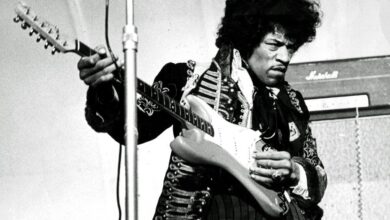How Eurovision is shining a light on Italy’s radically changing music scene

Barely a decade ago, Italian radio stations were time machines. Tune in and you’d be treated to classic songs by past greats such as Renato Carosone and Jimmy Fontana, or perhaps a saccharine pop ballad by Tiziano Ferro. Today, the country’s music landscape couldn’t be more different.
It started with Eurovision. In 2019, Italian delegate Mahmood narrowly missed out on first place (much to the chagrin of his fans). He’d captivated audiences with his original song “Soldi”, which blended hip-hop beats with nods to his Egyptian heritage. It was a superb riposte to the far-right naysayers who’d questioned the 26-year-old’s shock win at Sanremo – the Italian competition that decides that year’s Eurovision contestant. Despite protests from figures such as former deputy prime minister Matteo Salvini, Mahmood excelled on the global stage, while “Soldi” topped the charts in four countries.
Two years later, it was Maneskin’s turn. Outrageous and flamboyant, the rock band wielded a volcanic stage presence that sent tremors around the world long before rehearsals got underway. Their song “Zitti e Buoni” was a guitar-grinding, head-banging track that made them Eurovision champions last May. Less than a year later, Variety was crediting them with reviving rock’n’roll in the US.
Maneskin and Mahmood are just two cases of how breaking tradition has done Italy the world of good. “The Italian music scene has changed enormously in the last five years,” Nur Al Habash, music journalist and founder of Italia Music Export, tells me. “Our charts used to be dominated by established pop legends such as Laura Pausini or Tiziano Ferro – artists who started their career in the Nineties or even earlier – and successfully resisted market trends for almost 20 years. And then, in a matter of months, they all got surpassed by a new generation of rap and trap artists.” Italy’s music landscape is now dominated by these acts – Sfera Ebbasta, Ghali, Capo Plaza, Rondodasosa, Madame, Anna – who are attracting attention in the UK, US, and rest of Europe. “If you’re a rock fan looking for the next Maneskin, I’m sorry to say those guys are kind of unique in our music scene,” Al Habash says.
The genre that is thriving the most in Italy is undoubtedly rap. Al Habash cites a “massive amount” of up-and-coming drill and trap-influenced acts emerging from all corners of Italy, often incorporating their music with regional influences. “More good news is that, finally, a new generation of young female artists is taking the stage,” says Al Habash, who is a member of shesaid.so, a community of women and gender minorities working in the music industry. “In a few years’ time, I believe we will have a long list of impressive female hitmakers.”
As of 2021, Italy now ranks among the top 10 countries with the biggest global music share, muscling up against heavyweights including the US, Japan, Canada and France. Al Habash credits a younger audience becoming the market’s majority for this uptick: “People listening to music, buying records and attending gigs are now mainly under 30.” Meanwhile, artists who once would have been confined to the underground circuit are getting snapped up by major labels.
“After years of domination by talent shows providing the mainstream with new artists, there has been a shift of (former) indie/rock artists approaching the world of pop music and TV,” says Anna Zò, operative director of Linecheck Music Meeting and Festival in Milan. “People with grassroots and independent spirit have finally realised that it might take mainstream exposure to reach enough people to make a decent living of it”.
She says the shift to streaming has helped to solve what was once a huge piracy problem in Italy, and success is also thanks to some of the bigger organisations realising that wider grassroots teams often play a part in an artist’s success. “They provide those teams – managers, agents, smaller labels – with the cash they need to make things happen, instead of signing artists away or splitting up teams,” she says. “There are also plenty of new small and medium festivals following the more established ones [with] an independent approach to live music.”
Leading the charge are festivals such as Ypsigrock, which takes place in the picturesque medieval town of Castelbuono, Sicily. Its organisers have made a habit of never booking the same act twice, and to date have hosted artists from overseas including The National, Fat White Family, Bipolar Sunshine, Fontaines DC and Let’s Eat Grandma. But what it prides itself in is promoting homegrown talent with an international appeal. “It’s unusual to experience a festival with established artists, like The National or this year The Flaming Lips, alongside new artists in a small but characterful setting such as ours,” says Ypsigrock organiser Vincenzo Barreca. In recent years, the festival has seen a younger demographic attending, along with curious international music fans. “Festivals like ours, which have a positive [global] tastemaker reputation are instrumental [in introducing local] talent to international artists, media, industry, and of course the audience… so Italian artists are embedded in a natural international context,” Barreca’s colleague, Gianfranco Raimondo says.
Now, in 2022, Italy is serving up fierce competition with not one but two Italian acts. Duo Mahmood and Blanco are representing the country with their poignant ballad “Brividi” (“Chills”), while Italian artist Achille Lauro is this year’s entry for San Marino. Already well-established in his home country, Lauro has demonstrated a departure from his usual breezy pop-rock sound. Titled “Stripper”, it goes heavy on the singer’s breathy rock vocals, chugging riffs and an all-out chorus that pays tribute to Eighties hair bands.
Unlike the UK, which frequently sends complete unknowns as our representatives, Italy knows what makes the Eurovision audience tick. Its contestants tend to be pros when it comes to both live performances and the recording studio – not to mention they already have an army of adoring fans ready to cheer them on. Clearly, there’s something in the San Pellegrino.





